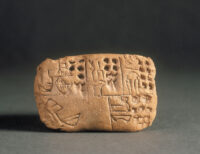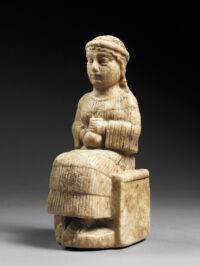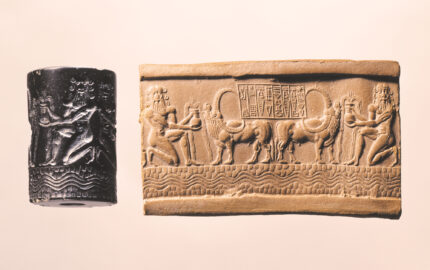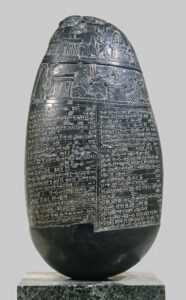The Getty Villa Museum is currently hosting an exhibition dedicated to Mesopotamian history from the dawn of the first cities in the Fertile Crescent around 3200 B.C. to Alexander the Great’s conquest of the Persian Empire in 331 B.C. An array of rare artifacts — sculptures, cuneiform tablets, cylinder seals, jewelry, paintings, bricks, decorative friezes — of exceptional quality, almost all of them on loan from the Louvre, are on display at the museum in Malibu through August 16th. It was scheduled to open on March 18th, 2020, but was preempted by you-know-what. The Louvre was kind enough to extend the loan for more than a year and the exhibition finally opened on April 21st.
The Getty has put together a fun and informative series of workshops and lectures to accompany the exhibition. Circumstances forced them online, which gives us the opportunity to enjoy events virtually that we would not have been able to attend in person. Want an excuse to make a ton of cookies while learning how to write cuneiform? Now you’ve got one.
 For an overview of Mesopotamian history as represented by the artifacts in the exhibition, watch this lecture by Dr. Ariane Thomas, director of the Department of Near Eastern Antiquities at the Louvre. I particularly love that the inscriptions on the objects are fully translated on the presentation slides, which is essential given the central role of cuneiform to Mesopotamian civilizations. Also 22 minutes in is an excerpt from the Epic of Gilgamesh read out loud. This is the first time I’ve heard Babylonian spoken.
For an overview of Mesopotamian history as represented by the artifacts in the exhibition, watch this lecture by Dr. Ariane Thomas, director of the Department of Near Eastern Antiquities at the Louvre. I particularly love that the inscriptions on the objects are fully translated on the presentation slides, which is essential given the central role of cuneiform to Mesopotamian civilizations. Also 22 minutes in is an excerpt from the Epic of Gilgamesh read out loud. This is the first time I’ve heard Babylonian spoken.
Delve deeper into cuneiform tablets in this presentation by historian Dr.  Amanda Podany who examines the religious, political, legal and economic significance of writing in Mesopotamia and examines the lives of three ancient Mesopotamians as revealed in cuneiform inscriptions: Enheduanna (24th century B.C.), daughter of King Sargon, high priestess of the moon god Nanna, the world’s first known poet, the 18th century B.C. scribe Pagirum and Hammurabi, king and lawgiver.
Amanda Podany who examines the religious, political, legal and economic significance of writing in Mesopotamia and examines the lives of three ancient Mesopotamians as revealed in cuneiform inscriptions: Enheduanna (24th century B.C.), daughter of King Sargon, high priestess of the moon god Nanna, the world’s first known poet, the 18th century B.C. scribe Pagirum and Hammurabi, king and lawgiver.
Next archaeologist Tate Paulette, expert on ancient spirituous beverages, explores Mesopotamia’s rich beer culture as documented in written, artistic and archaeological records. The lecture covers the history of beer in Mesopotamia, how it was brewed and drunk, and modern attempts to recreate it.
 Last but certainly not least is my favorite internationally-renown cuneiform expert, Dr. Irving Finkel of the British Museum, whose last visit to the Getty featured him taking on all comers at the Royal Game of Ur. Being a more innocent pre-pandemic era, that event was not filmed, much to my disappointment, but this time his discussion of the origins of writing is open to all of us from the comfort of our own homes via Zoom. From Laundry Lists to Liturgies: The Origins of Writing in Ancient Mesopotamia kicks off on August 11th at 11:00 AM Pacific Time. Registration is required and free. Presumably the recording will be made available on YouTube like its predecessors. See you there!
Last but certainly not least is my favorite internationally-renown cuneiform expert, Dr. Irving Finkel of the British Museum, whose last visit to the Getty featured him taking on all comers at the Royal Game of Ur. Being a more innocent pre-pandemic era, that event was not filmed, much to my disappointment, but this time his discussion of the origins of writing is open to all of us from the comfort of our own homes via Zoom. From Laundry Lists to Liturgies: The Origins of Writing in Ancient Mesopotamia kicks off on August 11th at 11:00 AM Pacific Time. Registration is required and free. Presumably the recording will be made available on YouTube like its predecessors. See you there!
